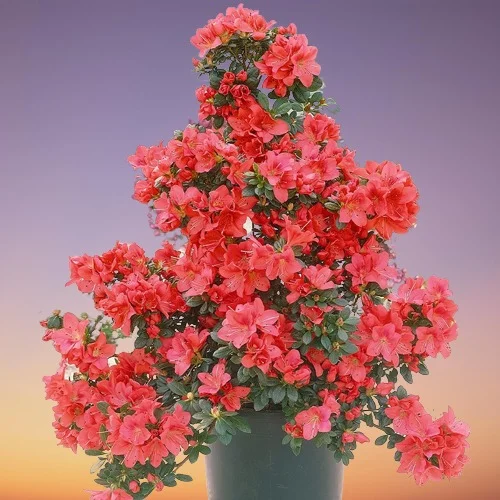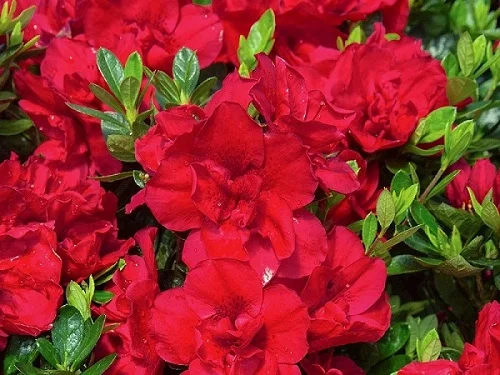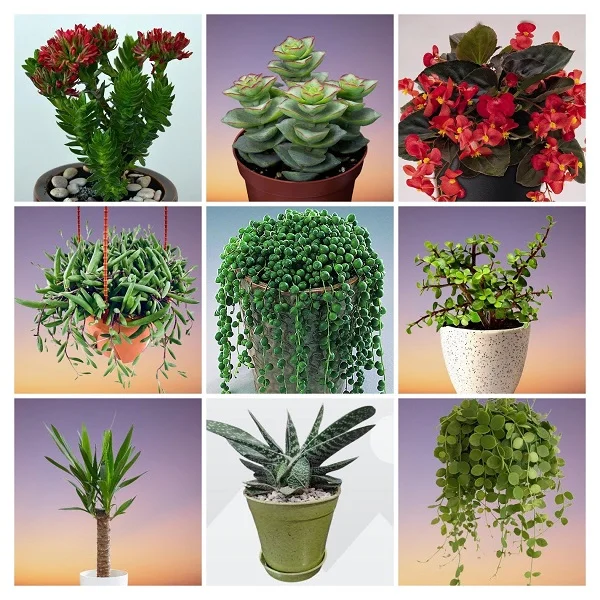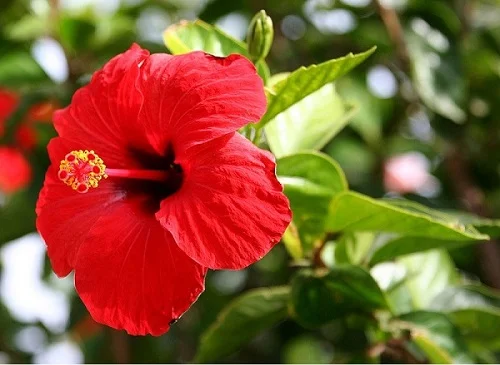Indian Azalea (Rhododendron simsii) Care, Common Problems and Solutions
Some links in this post may be affiliate links
Rhododendron simsii (Indian Azalea) prospers in bright indirect light, cool to average warmth, moderate humidity and consistently moist, rich, well-drained soils coupled with fortnightly feeding in the growing season.
The Rhododendron simsii is a breathtaking shrub. In this guide, we will explore everything you need to know about growing and propagating this plant, including lighting, watering, soil preferences, and solutions to common problems.
Rhododendron simsii is among the popular flowering plants and bears glossy, green, egg-shaped leaves with hairy leaf margins.
Indian Azalea are evergreen plants which will add a splash of color when in bloom but lasts a short period indoors. It is only displayed indoors when in bloom after which it is taken outdoors until the next bloom or discarded altogether.
In warm climates, Indian Azalea will thrive outdoors. But in the cold regions, it can only be grown as a container plant for a patio or a deck which is brought inside in winter.
Indian Azalea is a popular plant in India where it is grown as a garden plant and the flowers are used for religious purposes. It is hardy in USDA Zones 7-9.

Botanical name: Rhododendron simsii
Family: Ericaceae
Common names: Indian Azalea
Origin
Rhododendron simsii is native to East Asia in China, India and Taiwan.
How big do Rhododendron simsii get?
Rhododendron simsii can grow to a height of 5-6 feet and 5-6 feet wide. Most of the plants grown nowadays as Indian Azalea are cultivars and hybrids of Rhododendron simsii which rarely exceed 2-4 feet.
Flowers
The blooms are terminal meaning the entire plant blooms at one time which makes a colorful display. They are a profusion of shades of pink, red, white, peach, lavender or bi-colors.
The large, funnel-shaped flowers occur in clusters of 2-5 and are about 2 in. wide. They may be single or double and may sometimes have ruffled petals. Blooming occurs in spring and may last upto 3-4 weeks.
Are Rhododendron simsii poisonous?
Rhododendron simsii is toxic to humans and pets as indicated by ASPCA. If ingested it can cause a burning sensation in the mouth, drooling, vomiting, diarrhea and lethargy. Keep it from the reach of children, cats, dogs, and other pets.
Where to Buy
Azalea Plants are a beautiful addition to any plants collection, you may acquire them online from Etsy (Link to Etsy).
Rhododendron simsii Care Indoors
Caring for Rhododendron simsii involves giving it bright indirect light, cool to average warmth of 12-180C, moderate humidity of 50-55% and consistently moist, fertile, well-drained soils coupled with fortnightly feeding during the growing season.
Container grown Indian Azalea requires repotting only when it has outgrown its current pot as it blooms best when pot-bound. Cutting back of the stems is necessary after flowering to encourage more flowering. Keep reading for more on these growing conditions and how to achieve them.

Watering
Water your Rhododendron simsii liberally in spring and summer while allowing the top 1-2 inches of soil to dry out between waterings. Keep the soil consistently moist but not soggy to prevent yellowing and rotting.
Decrease watering in fall and winter as growth is minimal at this time to keep the soil slightly moist. Do not allow the soil to dry out completely to avoid wilting, drooping and leaf drop.
For container-grown plants, do not allow the plant to sit in soggy soil. Ensure that the container has adequate drainage holes and the soil is well-drained.
Discard any excess water from the catch plate to prevent the soil from gettting soggy as it can lead to root-rot and death of the plant.
Avoid watering the plant with too cold water to avoid shocking this tropical plant which can result in leaf and flowerbud drop.
Occasionally water the plant by the immersion method as it ensures that the soil is thoroughly wetted. Use chlorine-free water like rain water or filtered water to avoid yellow leaves.
Light requirements
Do Rhododendron simsii like sun or shade?
Rhododendron simsii grows best in bright indirect light. Keep it away from direct sunlight to prevent scorching of the leaves. Place it infront of a large, brightly-lit window but do not allow the sun rays to fall on the leaves.
If the light is too low, the plant will become leggy and will not bloom. Where the natural lighting is not adequate, consider investing in a grow light as enough light is necessary to prolong the life of the plant.
Regularly rotate the pot to ensure that the plant receives light on all sides for even growth and prevent unbalanced growth.
Outdoors, situate the Rhododendron simsii in a shaded spot like under the trees, under the house eaves and other shaded places.
Temperature and Humidity
Indian Azalea prefers cool to average temperatures of 12-180C and a minimum of 100C in winter. Keep it away from drafts to as they can cause leaf drop, flowerbud drop and slow growth.
Maintain a moderate humidity of 50-55%. If the air is too dry, set the pot on a wet pebble tray or use a cool mist humidifier to raise humidity and keep the plant thriving.
Do not mist the leaves as excessive moisture on the foliage can encourage fungal disease infestations. In addition, ensure that there is good air circulation.
Container-grown plants should be brought indoors when the temperatures begin to drop in winter and taken back outdoors in spring when the threat of frost has passed as Indian Azalea is not frost hardy.
To keep the soil warm in fall and winter, apply a 2-3 inches mulch of dry vegetation on the soil surface but take care not to let the mulch come into contact with the stem to prevent rotting.
Fertilizer
What is the best fertilizer for Rhododendron simsii?
Rhododendron simsii is an acid-loving plant. To keep it happy, feed it with a fertilizer formulated for acid-loving plants every 2-3 weeks in spring and summer. Avoid over-fertilizing, as it can lead to burnt leaf edges and poor flowering.
Withhold feeding in fall and winter as growth is reduced at this time. Do not feed a plant that is in flower as it can shorten the flowering period.
Regularly flush out accumulated salts from the soil by running a stream of water through the soil until it drains through the drainage hole.
Potting Mix
The best potting mix for Indian Azalea should be free-draining, rich in organic matter and acidic at a PH of 4.5 to 6.0. Use a soil PH meter to confirm it is within this range. If the PH is not within the recommended range, it should be ammended.
To increase PH (if it is too acidic), add lime to the soil. To decrease PH (if it is too alkaline), add soil sulphur. Allow a 2 weeks period for the soil to correct the PH. Check out this quality potting mix on Amazon for container grown plants.
Repotting
When to repot Rhododendron simsii
Repot a container grown Indian Azalea during the growing season, only when the plant is extremely pot-bound; it blooms more when root-bound. Usually repotting every 2-3 years is enough.
When you notice any of the following, it is time to repot your Rhododendron simsii;
- Roots growing through the drainage hole
- The soil drying out faster than before
- Wilting and leaf drop.
Caution: Do not repot a plant that is in flower as the repotting shock can shorten the flowering period.
How to repot Rhododendron simsii
- At least one day before repotting, thoroughly water the plant to make it easier to repot as well as reduce transplanting shock.
- Select a pot 1 size larger than the current one that has a drainage hole to prevent root-rot and death of the plant. Check out these pots with drainage holes on Amazon.
- Place a layer of gravel in the bottom of the pot to enhance drainage and prevent the soil from blocking the drainage holes.
- Fill the pot a third way with the recommended soil and slightly moisten it.
- Take the plant out of its pot, loosen the soil around the roots and shake off excess soil.
- Inspect the roots and cut away dead roots. To keep the plant small, cut off a third of the roots. Avoid disturbing the roots excessively during repotting.
- Position the plant in the center of the pot, spread out the roots and fill the pot with the soil while firming the soil around the plant.
- Water the soil liberally until water comes out through the drainage holes and replace the plant to its usual position.
Pruning & Maintenance
How do I make my Rhododendron simsii bushy?
Pinch off the growing tips regularly to encourage branching and growth of a bushy compact plant as well as attain the shape and size you desire.
Cutback the stems to the desired height, yearly after blooming. This will encourage growth of new stem tips from which the flowers grow which means the plant will bloom even more.
Remove dead flowers and leaves to maintain the plant neat and tidy as well as reduce pest and disease infestations.
Propagation
Rhododendron simsii propagation can be done from stem cuttings but they take long to root and do not stay true to type. It is preferable to buy a plant from the breeders.

Rhododendron simsii Problems
Rhododendron simsii (Indian Azalea) problems are leaf drop, yellow leaves, plant dying, curling and drooping leaves, brown leaves, flowerbud drop, poor flowering, pests and diseases among others. Keep reading for more on these problems and how to fix them.
Leaf drop
Why is my Indian Azalea losing its leaves?
Your Indian Azalea is losing its leaves due to inconsistent watering, drafts, and low light.
How to fix it
Inconsistent watering: Water consistently to prevent the soil from getting soggy or too dry for a prolonged period. Use a pot with a drainage hole and well-draining soil.
Drafts: Keep it away from drafts emanating from AC units, windy doors, drafts windows heat sources among others to maintain temperatures of 12-180C.
Low light: Place the plant in a brighter spot where it will receive bright indirect light or instal grow lights if the natural lighting is not adequate.
Yellow leaves
Why are the leaves on my Rhododendron simsii turning yellow?
The leaves on your Rhododendron simsii are turning yellow due to use of hard water, overwatering, and nutrient deficiency.
How to fix it
Hard water: Use filtered water or rain water; Azaleas are acid-loving plants and should not be watered with hard water as it raises the soil PH.
Overwatering: Do not water on a schedule. Water only when the top 1-2 inches of soil dry out.
Nutrient deficiency: Feed the plant with an acidic fertilizer every 2-3 weeks in spring and summer.
Plant dying
Why do my Rhododendron simsii keep dying?
Your Rhododendron simsii are dying due to root-rot which is common in soggy soil. The disease is characterized by yellowing and wilting of the leaves which is rapidly followed by browning and plant collapse.
How to revive a dying Rhododendron simsii
- Carefully slip the plant out of its pot and inspect the roots.
- Trim brown-black mushy roots and treat the healthy roots with a copper-based fungicidal solution as indicated by the manufacturer.
- Disinfect the pot with the fungicidal solution or use a fresh pot to repot the plant in fresh, well-draining soil.
- Do not water the plant immediately and keep it dry for 5-7 days before you can resume watering.
- To prevent root-rot in the future, use a pot with a drainage hole and well-draining soil to prevent the soil from soggy.
- Cut down watering in fall and winter as growth is reduced at this time; maintain the soil slightly moist.
Curling and drooping leaves
Why are my Rhododendron simsii leaves curling and drooping?
Your Rhododendron simsii leaves are curling and drooping due to underwatering, dry air, and temperature stress.
How to fix it
Underwatering: Water when the top 1-2 inches of soil feel dry to the touch. Do not allow the soil to dry out completely.
Dry air: Set the pot on a wet pebble tray, use a cool mist humidifier or group the plants together to elevate humidity.
Temperature stress: Keep the plant away or protect it from both hot and cold drafts to avoid extreme temperatures.
Brown leaves
Why are the leaves on my Rhododendron simsii turning brown and falling off?
The leaves on your Rhododendron simsii are turning brown and falling off due to underwatering, direct sunlight, and salts buildup.
How to fix it
Underwatering: Water when the top few inches of soil dry and do not leave the soil to dry out completely.
Direct sunlight: Keep the plant away from direct sunlight or use a light curtain to filter the sunlight.
Salts buidup: Flush out accumulated salts from the soil every 1-2 months by running a stream of water through the soil until it drips through the drainage hole.
Flowerbud drop
Flowerbud drop in Rhododendron simsii is due to underwatering, incorrect feeding, dry air, and temperature stress.
How to fix it
Underwatering: Water when the top 1-2 inches of soil dry out. Do not let the soil ball dry out completely.
Incorrect feeding: Feed it every 2-3 weeks in the growing season (spring and summer only) with an acidic fertilizer.
Dry air: Set the pot on a wet pebble tray or use a humidifier to maintain a high humidity.
Temperature stress: Protect the plant from drafts to maintain a temperature of 12-180C.
Poor flowering
Poor flowering in Indian Azalea grown is caused by improper pruning, overfeeding, and too little light.
How to fix it
Improper pruning: Cutback the stems after blooming to encourage growth of new stem tips from which the flowers grow.
Overfeeding: Feed the plant every 2-3 weeks in spring and summer. Too much fertilizer will result in foliage growth at the expense of flower production.
Too little light: Position the plant under bright indirect light or use a grow light is the natural light is not enough.
Pests
Common pests in Rhododendron simsii are spider mites, scale insects and aphids. Regularly inspect the plant for these pests and take timely control measures. Isolate the plant and treat with neem oil or insecticidal soap as per the manufacturers' recommendations.
Diseases
Indian Azalea is prone to powdery mildew which causes the new leaves to curl, become pale, then brown and die. Discard the plant as it will not recover for this disease.
Conclusion
Indian Azalea (Rhododendron simsii) is a gorgeous, rewarding plant that thrives with proper care. By maintaining cool temperatures, acidic soil, and regular watering, you can enjoy its stunning blooms for years.
You liked it? Share on social media.
Related Content
Amazon Associates Disclosure
Homeplantsguide.com is a participant in the Amazon Services LLC Associates Program, an affiliate advertising program designed to provide a means for sites to earn advertising fees by advertising and linking to amazon.com.


